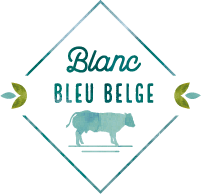Double muscling
Text by Iris Kolkman, Calving problems and calving ability in the phenotypically double muscled Belgian Blue breed, Merelbeke, 2010.
Around the 1990‘s it was discovered that the extreme muscularity characterizing the Belgian blue breed had its origin in a mutation of the myostatin (mh) gene. Myostatin is a member of the TGF super family of growth and differentiation factors (McPherron and Lee, 1997). In cattle this gene has been mapped 3.1cM from microsatellite TGLA44 on the centromeric end of chromosome 2 (Grobet et al., 1997). In conventional animals, skeletal muscle growth is repressed by myostatin. A specific mutation in the mh-gene causes inactivation and gives rise to ―muscular hypertrophy‖ resulting in an increase in muscle mass of about 20% (Grobet et al., 1997). This increased muscle mass is created by an increase in the number of muscle fibers (hyperplasia; Grobet et al., 1997; Bellinge et al., 2005) rather than an increase in their individual diameter. The hypermuscularity in the DM-BB breed is due to a deletion of 11 nucleotides (Grobet et al., 1997), which has been mapped to the centromeric tip of chromosome 2 under a recessive model, suggesting an autosomal recessive inheritance (Charlier et al., 1995). A similar mutation in the mh-gene has been shown to be the cause for double muscling in the Asturiana breed (Grobet et al., 1998), the Blonde d‘Aquitaine, the Limousin, the Parthenaise, the Rubea Gallega (Karim et al., 2000) and the South Devon (Smith et al., 2000). Other mutations also causing double muscling were discovered around that time in the Piedmontese, the Gasconne (Kambadur et al., 1997), the Maine-Anjou, the Charolais, the Limousine (Karim et al., 2000) and the Marchigiana breed (Cappucio et al., 1998; Marchitelli et al., 2003).
Complete text available HERE (pdf file)







